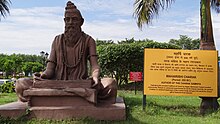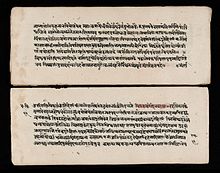For other uses, see Charak (disambiguation).
| This article needs additional citations for verification. Please help improve this article by adding citations to reliable sources. Unsourced material may be challenged and removed. Find sources: "Charaka" – news · newspapers · books · scholar · JSTOR (June 2013) (Learn how and when to remove this message) |
| MaharshiCharaka | |
|---|---|
 Posthumous portrait of Charaka Posthumous portrait of Charaka | |
| Born | Charaka c. 1th century BCE Ancient India |
| Died | c. 3rd century CE |
| Known for | Charaka Samhita |
| Scientific career | |
| Fields | Medicine |
Charaka was one of the principal contributors to Ayurveda, a system of medicine and lifestyle developed in ancient India. He is known as a physician who edited the medical treatise entitled Charaka Samhita, one of the foundational texts of classical Indian medicine and Ayurveda, included under Brhat-Trayi.
Charaka, also known as Charak acharya, was an ancient Indian physician and scholar who made significant contributions to the field of Ayurveda. Ayurveda is a traditional system of medicine that originated in Indian subcontinent.
Charaka is believed to have lived during the 4th century BCE, although the exact dates of his birth and death are uncertain. He is considered one of the principal contributors to the Charaka Samhita, an ancient Ayurvedic text that is one of the foundational texts of Ayurvedic medicine.
The Charaka Samhita is a comprehensive treatise on various aspects of medicine, including etiology, diagnosis, treatment, and ethical considerations. It covers a wide range of topics, including anatomy, physiology, herbal medicine, surgical techniques, and the use of minerals and metals in medicine.
Charaka's approach to medicine was holistic and focused on understanding the body as a whole. He emphasized the importance of maintaining a balance among the three doshas (vata, pitta, and kapha) and believed that disease resulted from an imbalance in these doshas. His treatments aimed to restore this balance through dietary changes, herbal remedies, lifestyle modifications, and therapies such as massage and detoxification.
Date
After surveying and evaluating all past scholarship on the subject of Charaka's date, Meulenbeld concluded that, the author called Charaka cannot have lived later than about 150-200 CE and not much earlier than about 100 BCE. Maharishi Charaka is also known as the court physician during the reign of the famous king Kanishka of Kushan Empire.
Charaka has been identified by some as a native of Kashmir. Professor Sylvain Lévi after discovering Buddhist manuscripts in Central Asia and China, came to the conclusion that the famous Charaka, the author of Charaka Samhita belonged to Kashmir. The recension of the text available to us today was done by Acharya Dridhabala, a scholar of Kashmir. Jejjata, the author of commentary on the Charaka Samhita, was also Kashmiri and so was Udbhatta who commented upon Sushruta Samhita.
Charaka is also associated with the University of Taxila.
Charaka and the Ayurveda

The term Charaka is a label said to apply to "wandering scholars" or "wandering physicians". According to Charaka's translations, health and disease are not predetermined and life may be prolonged by human effort and attention to lifestyle .
Charaka seems to have been an early proponent of "prevention is better than cure" doctrine. The following statement is attributed to Charaka:
A physician who fails to enter the body of a patient with the lamp of knowledge and understanding can never treat diseases. He should first study all the factors, including environment, which influence a patient's disease, and then prescribe treatment. It is more important to prevent the occurrence of disease than to seek a cure.
A body functions because it contains three dosha or principles, namely movement (vata), transformation (pitta) and lubrication and stability (kapha). The doshas correspond to the Western classification of humors, wind, bile, and phlegm. These doshas are produced when dhatus (blood, flesh and marrow) act upon the food eaten. For the same quantity of food eaten, one body, however, produces dosha in an amount different from another body. That is why one body is different from another.
Further, he stressed, illness is caused when the balance among the three doshas in a human body are disturbed. To restore the balance he prescribed medicinal drugs. He also describes various parasitic worms(krimi).
Charaka studied the anatomy of the human body and various organs. He gave 360 as the total number of bones, including teeth, present in the human body. He considered the heart to be a "controlling centre" . He claimed that the heart was connected to the entire body through 13 main channels. Apart from these channels, there were countless other ones of varying sizes which supplied not only nutrients to various organs but also provided passage to waste products. He also claimed that any obstruction in the main channels led to a disease or deformity in the body .
Charaka Samhita
Main article: Charaka Samhita
Agnivesha, under the guidance of the ancient physician Atreya, composed an encyclopedic medical compendium in the eighth century BCE, the Agnivesha Samhitā. The work received little attention. The Agnivesha Samhitā was revised by Charaka and renamed the Charaka Samhitā. In this form it became well known. The Charaka Samhitā was itself later supplemented with an extra seventeen chapters added by the author Dṛḍhabala [Wikidata], while retaining its name. The Charaka Samhita is one of the two foundational text of Ayurveda, the other being the Sushruta Samhita. For two millennia it remained a standard work on the subject and was translated into many foreign languages, including Arabic and Latin.
See also
References
- Meulenbeld, Gerrit Jan (1999). "10. Caraka, his identity and date". A History of Indian Medical Literature, Vol. 1A, Part 1. Groningen: E. Forsten. p. 114. ISBN 9069801248. OCLC 42207455.
- Melissa Stewart. Science in Ancient India. F.Watts, 1999. p. 23.
- Madan Gopal. India Through the ages. Publications Division, Ministry of Information & Broadcasting, Government of India, 1990. p. 213.
- Martin Levey, Early Arabic Pharmacology: An Introduction Based on Ancient and Medieval Sources, Brill Archive (1973), p. 10
- P. N. K. Bamzai, Culture and Political History of Kashmir - Volume 1, M D Publications (1994), p.268
- Prithvi Nath Kaul Bamzai. History of Kashmir: Political Social Cultural From the Earliest Times. Metropolitan Book Co Pvt Ltd, 1973. p. 259. ISBN 9788183394260.
- Birgit Heyn, Ayurveda: The Indian Art of Natural Medicine and Life Extension, Inner Traditions / Bear & Co (1990), p.25. 'The Wanderer' (the meaning of Charaka's name), lived and taught around BC 700 at the medical faculty of the University of Taxila in the Punjab during a culturally peak period.""
- Priyadaranjan Ray. Caraka Samhita: A Scientific Synopsis.
- Priyadaranjan Ray. Caraka Samhita: A Scientific Synopsis pg-37.